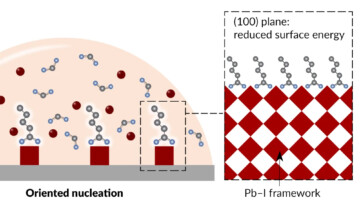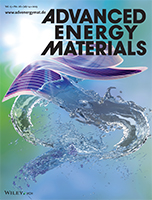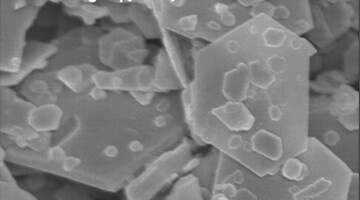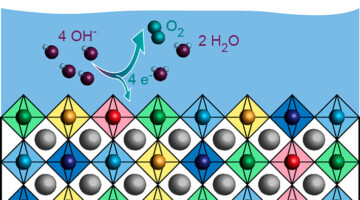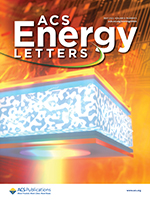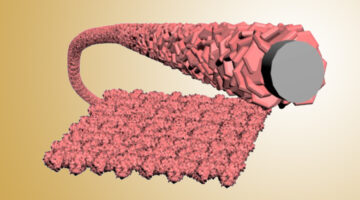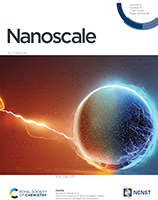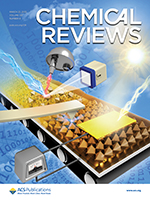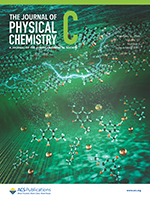Multimodal probes revealed a way to prevent the formation of undesirable phases in a perovskite-type compound that shows promise for the efficient harvesting of light for solar cells. The work led to new fabrication protocols that resulted in devices with improved power-conversion efficiencies and operational stability. Read more »![]()
![]()
Toward High Efficiency Water Processed Organic Photovoltaics: Controlling the Nanoparticle Morphology with Surface Energies
Researchers achieve power conversion efficiencies approaching 10% by careful control of the nanoparticle and thin film morphologies thanks to surface energy considerations. This approach opens the route to low environmental footprint photovoltaics. Representing the promise of this sustainable direction in organic photovoltaics, the image shows the deposition of the active layer from water-based nanoparticles inks. Read more »
Surface Engineering Boosts Water-Splitting Efficiency
Researchers modified the surface of an electrocatalyst to maximize its efficiency at splitting water. The optimized material is approximately 40 times more efficient than similar commercial electrocatalysts and could help make the production of clean hydrogen fuel more sustainable and economical. Read more »![]()
![]()
Synergistic Effect Could Boost Production of Green Hydrogen
Researchers developed a composite material of earth-abundant elements that catalyzes the production of green hydrogen much more effectively than similar homogeneous compounds. The composite could potentially be used for efficient hydrogen generation without the need for rare and precious metals like platinum. Read more »
Impact of Thermal Stress on Device Physics and Morphology in Organic Photodetectors
Implementing organic photodetectors (OPDs) into Si-based manufacturing process requires high thermal resistance. This work showcases a comprehensive picture of the impact of high thermal stress (at 200 °C, up to 2 hours) on photosensing performance, bulk and interfacial morphologies, and device physics. Read more »
Increasing the Energy Density of Hybrid Supercapacitor Electrodes
Hybrid supercapacitors (HSCs) integrate the merits of batteries with those of supercapacitors. However, the fraction of active material in HSC electrodes has remained too low for commercial requirements. Now, researchers have found a clever way to increase the active-mass ratio to achieve dramatic improvements in key measures. Read more »
Sub-4 nm mapping of donor–acceptor organic semiconductor nanoparticle composition
We report, for the first time, sub-4 nm mapping of donor : acceptor nanoparticle composition in eco-friendly colloidal dispersions for organic electronics. This technology shows great promise for the optimization of organic semiconductor blends for organic electronics and photocatalysis and has further applications in organic core–shell nanomedicines. Read more »
In Situ and Operando Characterizations of Metal Halide Perovskite and Solar Cells: Insights from Lab-Sized Devices to Upscaling Processes
The performance and stability of metal halide perovskite solar cells strongly depend on precursor materials and deposition methods adopted during the perovskite layer preparation. This review presents an update of studies conducted in situ using a wide range of structural, imaging, and spectroscopic techniques, involving the formation/degradation of halide perovskites. Read more »
Electric Vehicle Batteries Could Get Big Boost With New Polymer Coating
Scientists have developed a conductive polymer coating—called HOS-PFM—that conducts both electrons and ions at the same time. This ensures battery stability and high charge/discharge rates while enhancing battery life. The coating also shows promise as a battery adhesive that could extend the lifetime of a lithium-ion battery from an average of 10 years to about 15 years. Read more »
A Study on the Reaction Mechanism of a Model Organic Cathode in Magnesium-Ion Batteries
Battery and analytical studies of a model benzoquinone-type cathode reveal reversible structural transformations driven by a new precedence of a unique dissolution/precipitation mechanism and raise the question regarding its prevalence in other organic cathode batteries. Read more »
- « Previous Page
- 1
- 2
- 3
- 4
- 5
- 6
- …
- 16
- Next Page »
